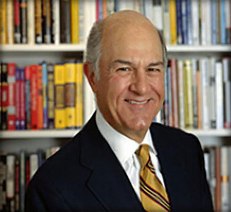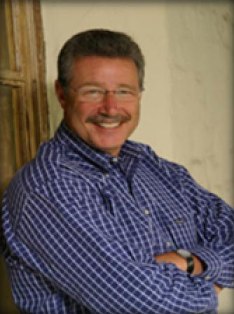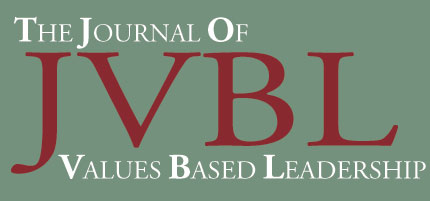- CONTENTS:
- Letter from the EditorLetter of Welcome by Senator Dick LugarFundamental Moral Orientations: Implications for Values-Based LeadershipAssuming the Leadership Role on Climate Change and Energy SecurityWe Lead from the Inside OutCitizen Engineers: Leaders in Building a Sustainable WorldTable of ContentsTurning Your Values into ValueValues‑Based Leadership: How Our Personal Values Impact the WorkplacePositively Deviant Organizational Performance and the Role of Leadership ValuesNotes Toward a Definition of Values‑Based LeadershipTable of Contents
- WE LEAD FROM THE INSIDE OUT

James M. Kouzes

Barry Z. Posner
JAMES M. KOUZES AND BARRY Z. POSNER, PH.D.
Abstract: This article makes the argument that becoming an effective leader is an inside-out process. Leaders, through self examination, realize their passions, values, and the legacy that gives meaning to their life. Leading a life that is congruent with one’s personal believes and values gives leaders the authenticity and credibility that their constituents desire. Once leaders have identified their values, they have a greater sense of stability, confidence and peace. Without firm core beliefs, a leader is perceived as inconsistent and untrustworthy and unlikely to be willingly followed. Answering the internal question “Who am I?” is crucial for leaders.
This article was adapted from an essay in A Leaders’ Legacy by James M. Kouzes and Barry Z. Posner (JosseyBass/Wiley, 2006).
Authentic leadership does not come from the outside in. It comes from the inside out. Inside-out leadership means becoming the author of our own story and the maker of our own history.
All serious leadership starts from within. That’s the only way we’ll ever be able to respond to what our constituents most expect and want from us. And what is that? What they most want from us is that we be genuinely who we are.
Just imagine this scene. Someone walks into the room right now and announces to you and your colleagues, “Hi, I’m your new leader.” At that very moment what do you want to know from this person? What are the questions that immediately pop into your mind? We’ve asked this question of many different groups, and the responses are almost always the same. People tell us they want to ask that new leader:
- Who are you?
- What do you stand for and believe in?
- Where do you want to take us?
- Why you?
- What qualifies you for this job?
- What makes you think you can do this?
- Do you really know what you’re getting yourself into?
- What changes are you planning to make?
Questions like these get to the heart of leadership. People always want to know some things about us — the person doing the leading — before they’re going to become the people doing the following. They want to know about what inspires us, what drives us, what informs our decisions, what gives us strength, what makes us who we are. They want to know about the person behind the mask of position. They want to know what gives us the confidence to think that we can actually pull this off. If we’re to leave a lasting legacy — regardless of the scale or scope of our aspirations — then we have to wrestle with questions such as these until we find answers that give meaning to our actions and to our lives.
The quest for leadership, therefore, is first an inner quest to discover who you are, and it’s through this process of self-examination that you find the awareness needed to lead. Self-confidence is really awareness of and faith in your own powers, and these powers become clear and strong only as you work to identify and develop them. The mastery of the art of leadership comes with the mastery of the self, and so developing leadership is a process of developing the self.
Leadership Begins When Something Grabs Hold of Us
Developing our selves as leaders begins with knowing our own key convictions; it begins with our values system. Clarifying our own values and aspirations is a highly personal matter, and no one else can do it for us. To exhibit harmonious leadership — leadership in which our words and deeds are consonant — we must be in tune internally. We must know who we are, what’s important to us, and what is not.
When Mike Sullivan started his new position in investor relations at Intel, he knew that he had to find what “grabbed him and wouldn’t let go.” He told us that he spent a lot of time thinking deeply about his values, talking them over with his spouse and closest friends, and that while this reflection was difficult, even challenging at times, it was well worth the struggle. In turn, he realized that the leadership challenges he was facing at work were the result of “preconceived ideas about leadership that were stereotypical, outdated and simply wrong.”
Exploring his inner territory led Mike to “clarity surrounding something that for many years had been a great mystery. I realized that passion inspires me to lead and that I will need to make manifest in my work those things I am passionate about in order to want to lead and to be emotive and empathetic with my constituents.” As a result of exploring and then struggling to make choices about what was really important, Mike became both clear and conscious of his values. Mike felt more grounded and confident. He explained how this insight directly impacted his leadership behavior:
I'd assumed a new position with responsibility for my company’s relationships with the Wall Street brokerage analysts who publish earnings estimates and buy/sell recommendations on our stock. We’ve been suffering from Wall Street’s perception that our competitor was gaining momentum in the market. Whereas I might ordinarily wait for my boss (who previously drove this function) to help devise a response, I felt confident in developing an engagement plan, crafting the story and messages, setting up meetings with analysts, and pulling senior managers into interviews to tell the analysts how we planned to compete and recover lost ground. Identifying my values and finding my voice was what gave me the confidence to take such a risk in my first weeks in a very visible new job.
Leadership begins with something that grabs hold of us and won’t let go. And this “something” will only be found when we are to take a journey through our inner territory — a journey that often requires opening doors that are shut, walking in dark spaces that are frightening, and touching the flame that burns. But at the end is truth.
Clarity of Values Builds Solid Support
This is precisely what we’ve found in several of our own studies. Clarity of personal values matters greatly to our feeling motivated, creative, and committed to our workplaces. When we’re clear about our personal values, we feel empowered, ready and prepared to take action. Ready to be a leader.
Tanveer Ahmad, an engineering manager with Sony, echoed these sentiments when he told us that he had learned “that clarifying one’s values and expressing one’s self clearly and confidently is an essential first step that leaders must undertake in order to build a firm grounding. Three are no short-cuts, workarounds or other easy alternatives to this primal step in the leadership journey.” Tanveer went on to explain that “one immediate payoff in developing a clear sense of values and communicating these values is that it serves to enlist willing constituents and builds a vital support base for the leader.” We’ve all heard the expression: “Leaders stand up for their beliefs.” Tanveer reminds us that to have a solid platform upon which to stand, our beliefs must be clear to us and clearly communicated to others. When these values are matched by our deeds, than we’ve earned the credibility required for others to put their trust in us, wanting to climb up and join us on that platform, knowing they’ll be supported.
When you’re not clear about your personal values, it’s hard to imagine how you can stand up for your beliefs, isn’t it? How can you speak out if you don’t know what’s important to you? How can you have the courage of your convictions if you have no convictions? Leaders who aren’t clear about what they believe in are likely to change their positions with every fad or opinion poll. Without core beliefs and with only shifting positions, would-be leaders are judged as inconsistent and derided for being “political” in their behavior.
We all know deep down that people can only speak the truth when speaking in their own voices. The techniques and tools that fill the pages of management and leadership books are not substitutes for whom and what we are. In fact, they can boomerang if thrown by a spin meister who’s mastered form but not substance.
After all, who’s the very first person you have to lead? Who’s the first person that must be willing to follow you? You are, of course. Until you passionately believe in something, it’s hard to imagine that you could ever convince anyone else to believe. And if you wouldn’t follow you, why should anyone else?
Developing leadership capacity is not about stuffing in a whole bunch of new information or trying out the latest technique. It’s about leading out of what is already in our souls. It’s about liberating the leader within us. It’s about setting ourselves free. It’s about putting our ears to our hearts and just listening. Clarity of values is essential in knowing which way, for each of us, is north, south, east or west. The clearer we are, the easier it is to stay on the path we’ve chosen. In exploring our inner territory and finding our voices, we calibrate an inner compass by which to navigate the course of our daily lives and to take the first steps along the journey of making a difference.
So, back to that leader who walks in the room and says, “Hi, I’m your new leader.” How would you answer the questions that others want to know about why they should follow you? What would you say when asked, “Who are you?”
Author Biographies
Jim Kouzes and Barry Posner are co-authors of the award-winning and best-selling book, The Leadership Challenge. The Leadership Challenge has received several book-of-the-year awards, been a selection of both the Fortune and Macmillan Executive Book Clubs, a BusinessWeek best-seller, been translated into fifteen languages, and sold over 1.5 million copies. Jim and Barry have coauthored more than a dozen other leadership books, including Credibility: How Leaders Gain It and Lose It, Why People Demand It (chosen by Industry Week as one of its year’s five best management books), A Leader’s Legacy (selected by Soundview Executive Book Summaries as one of the top thirty books of the year), and their latest, The Student Leadership Challenge. They also developed the highly acclaimed Leadership Practices Inventory (LPI), a 360-degree questionnaire for assessing leadership behavior, which is one of the most widely used leadership assessment instruments in the world. More than 350 doctoral dissertations and academic research projects have been based on their Five Practices of Exemplary Leadership® model.
Jim and Barry were named Management/Leadership Educators of the Year by the International Management Council. This honor puts them in the company of Ken Blanchard, Stephen Covey, Peter Drucker, Edward Deming, Frances Hesselbein, Lee Iacocca, Rosabeth Moss Kanter, Norman Vincent Peale, and Tom Peters, who are all past recipients of the award. In the book Coaching for Leadership, they were listed among the nation’s top leadership educators and in 2007 they were named among the Top 75 Best in Leadership Development by Leadership Excellence.
Jim Kouzes and Barry Posner are both at Santa Clara University, where Jim is the Dean’s Executive Professor of Leadership and Barry is Dean of the Leavey School of Business and Professor of Leadership. Jim and Barry are frequent conference speakers, and each has conducted leadership development programs for hundreds of organizations, including Apple, Applied Materials, AT&T, Australia Post, Bank of America, Bose, Cisco Systems, Community Leadership Association, Conference Board of Canada, Consumers Energy, Dell Computer, Deloitte Touche, Dorothy Wylie Nursing Leadership Institute, Egon Zehnder International, Federal Express, Hewlett- Packard, IBM, Jobs DR-Singapore, Johnson & Johnson, L. L. Bean, Lawrence Livermore National Labs, Lucile Packard Children’s Hospital, Merck, Mervyn’s, Network Appliance, Northrop Grumman, Roche Bioscience, Siemens, 3M, Toyota, United Way, USAA, Verizon, VISA, and The Walt Disney Company, along with scores of colleges and universities around the world.

